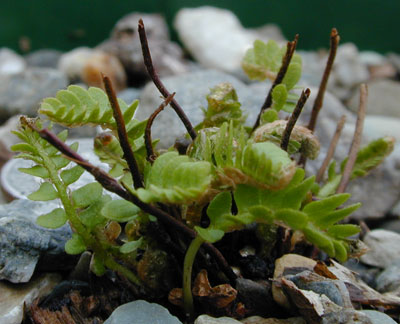|
Hardy Fern Home W. intermedia resources
All Ferns � Woodsiaceae �� Woodsia
�Other Genera
|
| Woodsia intermedia | ||
|
Etymology
Intermedia means being intermediate in color, form, or habit.
Description
Rhizome: erect, short, scaly.
Frond: 25 cm high by 4 cm wide, deciduous, monomorphic, blade/stipe ratio: 2:1. Stipe: straw-colored to brown, obliquely jointed at top, old stipe bases 1-2 cm., densely scaly at base, sparsely hairy and scaly throughout; scales lanceolate, pale brown, vascular bundles: 2, round or oblong. Blade: 1-pinnate, narrowly lanceolate or linear, somewhat narrower at the base, herbaceous, soft, hairy on both surfaces, also scaly beneath, scales linear. Pinnae: 4 to 12 pair, pinnae lanceolate or oblong-lanceolate, eared upwards at the base, 25 x 7 mm, upper pinnae adnate to the rachis; costae grooved above, grooves continuous from rachis to costae; margins undulate ; veins free, simple or forked, ending before the margin. Sori: round, in one row near the margin, indusium: cup-like dissected into shallow lobes, hairy, basal, surrounding, sporangia: brownish. Culture
Distribution: eastern Siberia, northeastern China, Korea, Manchuria, Japan.
Hardy to -30�C, USDA Zone 4.
Distinctive Characteristics
This looks like just a younger W. polystichoides, but it is always a smaller plant with fewer pinnae pairs. Also, the upper pinnae are adnate to the rachis. Both species are distinguished by having the stipes jointed at the top. The old stipe bases of W. intermedia are 1-2 cm.
Synonyms
Woodsia subintermedia Tzvelev Woodsia brantii Fr. & Sav. |
|
|
Notes
Compare to This and W. polystichoides are 1-pinnate. All other Woodsia are more divided.
Compare to This and W. polystichoides are 1-pinnate. All other Woodsia are more divided.

Woodsia intermedia. emergence April 11, old stipe basses are all just under 2 cm, last year brown, two year old tan. �Photo: Tom. |

Woodsia intermedia. at emergence, April 11, upper surface glabrous or glandular, margins hairy. �Photo: Tom. |

Woodsia intermedia. Early summer. The indusium here is much clearer than in W. polystichoides because the lower surface is far less scaly. �Scan: Tom Stuart |
